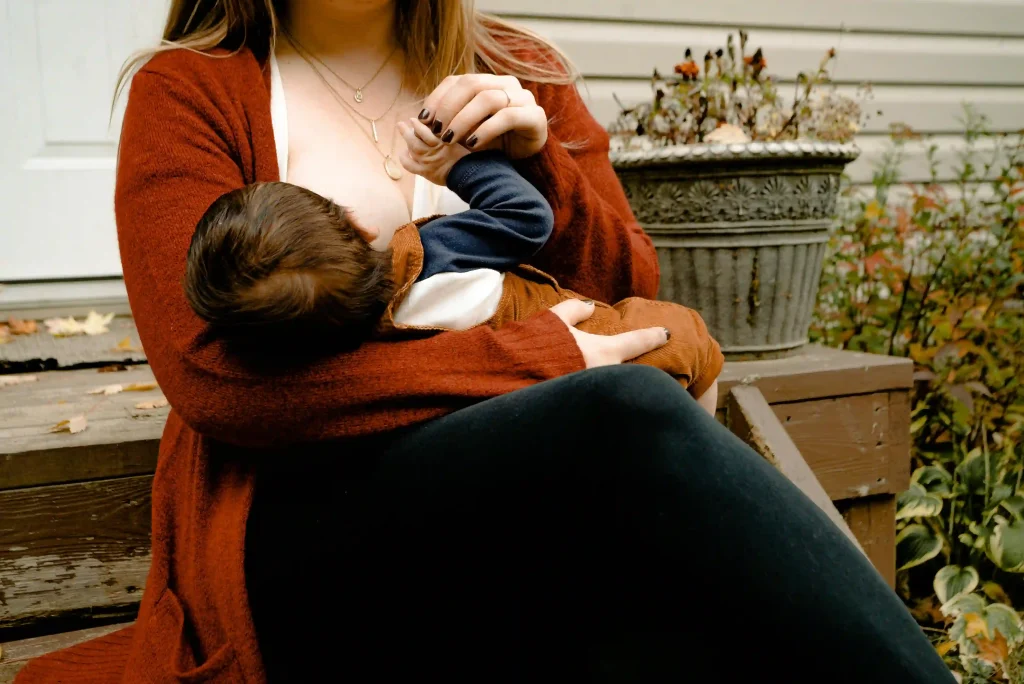Few things make a new mom more nervous than the question of whether or not their newborn is getting enough breastmilk. And if baby doesn’t naturally latch easy, breastfeeding can become both painful and frustrating for mom.
In today’s lesson, you’ll learn how to give basic breastfeeding instructions in Spanish through learning:
- Breastfeeding vocabulary in Spanish
- Describing different breastfeeding positions in Spanish
- Common problems with breastfeeding in Spanish
- How to know if baby is getting enough food
Check out the breastfeeding instructions in Spanish video lesson here:
Essential breastfeeding vocabulary in Spanish:
| Aferrarse Agarrarse | to latch |
| Alimentar(se) | to feed |
| Amamantar Dar pecho | to breastfeed |
| Colocar | to put / place |
| Desprender | to detach |
| El meñique | pinky finger |
| El pecho | breast |
| El pezón •La aureola •Los pezones adolorido | Nipple: •areola •sore nipples |
| El sacaleches | breastpump |
| Estimular la producción de leche | stimulate milk production |
| La boca totalmente abierta (como un bostezo) | the mouth totally open (like a yawn) |
| La comisura de la boca | the corner of the mouth |
| Los labios | lips |
| Rozar | to brush/rub lightly |
| Sellar | to seal |
| Una molestia | a bother / discomfort |
| Un dolor | pain |
Common breastfeeding positions described in Spanish:
| Nota general: Su bebé necesita estar bien alineado con la oreja, el hombro y la cadera en la misma línea, no con la cabeza torcida. | General note: Your baby needs to be well aligned with the ear, shoulder and hip in the same line, not with the head twisted. |
| La posición clásica: mamá está sentada con bebé en su regazo. | The classic position: mom is sitting with baby on her lap. |
| La posición inversa: las piernas del bebé están debajo del brazo de la mamá y los pies apuntando a su espalda. | The reverse position: the baby’s legs are under the arm of the mother and the feet pointing to her back. |
| La posición caballito: el bebé se sienta en una pierna de la mamá. | The little horsey position: the baby sits on one leg of the mother. |
| La posición acostada: ambos mamá y bebé están acostados. | Lying position: both mom and baby are lying down. |
| La posición reclinada: mamá está recostada y bebé está en el vientre de ella. | The reclining position: mom is lying down and baby is on her belly. |
Basic breastfeeding instructions in Spanish:
| 1. Agarre su pecho en la posición “c” con los 4 dedos debajo del pecho y el pulgar arriba y apriete levemente para presentar el pecho a su bebé. | 1. Grab your breast in the “c” position with all 4 fingers under the chest and the thumb above, squeeze slightly to present the breast to your baby. |
| 2. Roce el labio inferior con su pezón para provocar que su bebé abra la boca. | 2. Rub the lower lip with your nipple to provoke your baby to open their mouth. |
| 3. Cuando abra bien la boca (como si estuviera bostezando grande) coloque su boca en el pecho. | 3. When your baby opens their mouth wide (as if he were yawning big) put their mouth on your breast. |
| 4. Si sus mandíbulas se juntan sobre la aureola y sus labios se sellan sobre el pecho está en buena posición | 4. If your baby’s jaws come together around the areola and their lips seal around the breast, your baby is in a good position. |
Advice for when breastfeeding is difficult:
| Mucho dolor: •Si tiene mucho dolor, es probable que su bebé no se agarre bien al pecho. •Despréndalo deslizando su meñique en la comisura de su boca y vuelva a intentar. •Su bebé tiene que abrir la boca muy grande y agarrarse al pecho con la mayoría de la aureola dentro de su boca. | A lot of pain: •If you are in a lot of pain, it’s likely that your baby is not latching on well. •Detach your baby by sliding your pinky into the corner of the mouth and try again. •Your baby has to open their mouth very wide and latch onto the breast with most of the areola inside its mouth. |
| Grietas en el pezón: •Las grietas normalmente se causan por un problema de agarre. •Si tiene grietas, consulte con un experto en lactancia para que pueda identificar la causa y tratarla. | Cracks in the nipple: •Cracks are usually caused by a latching problem. •If you have cracks, consult a lactation expert to identify the cause and treat it. |
| Mastitis: •Si tiene dolor y enrojecimiento en alguna parte del pecho, es importante vaciar el pecho con más frecuencia. •Puede aumentar las tomas o usar un sacaleches. •Si no se mejora en 24 horas, o si también tiene fiebre, escalofríos y dolores musculares, necesita hacer una cita con su médico. | Mastitis: •If you have pain and redness in any part of the breast, it is important to empty your breast more frequently. •You can increase the amount of feedings or use a breast pump. •If you do not get better within 24 hours, or if you also have fever, chills, and muscle aches, you need to make an appointment with your doctor. |
| Poca producción de leche: •Es común preocuparse de que no produzca suficiente leche para su bebé. •Sin embargo, la mayoría de las mujeres sí producen lo suficiente para sus bebés. •Es importante recordar que la succión de las tomas de su bebé (o el sacaleches) es lo que estimula más producción de leche. | Low milk production: •It’s common to worry that you don’t produce enough milk for your baby. •However, most women do produce enough for their babies. •It is important to remember that the suction from your baby’s feedings (or breast pump) is what stimulates more milk production. |
How to know if baby is getting enough milk:
| 1. Si su bebé moja 6 o más pañales en 24 horas, está tomando suficiente leche. | 1. If your baby wets 6 or diapers in 24 hours, they are drinking enough milk. |
| 2. Si su bebé tiene movimientos regulares con consistencia suave, está tomando suficiente leche. | 2. If your baby has regular bowel movements with smooth consistency, they are drinking enough milk. |
| 3. Si su bebé aumenta de peso según lo esperado, está comiendo lo suficiente. | 3. If your baby gains weight as expected, they are eating enough. |




